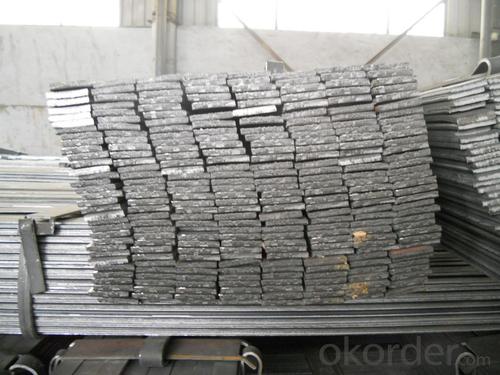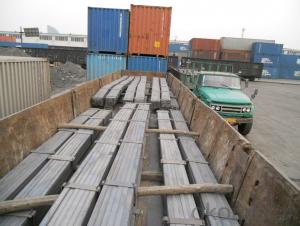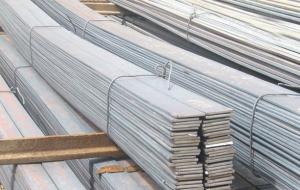GB Standard Steel Flat Bar with High Quality 65mm
- Loading Port:
- Tianjin
- Payment Terms:
- TT OR LC
- Min Order Qty:
- 25 m.t
- Supply Capability:
- 15000 m.t/month
OKorder Service Pledge
OKorder Financial Service
You Might Also Like
Product Description of GB Standard Steel Flat Bar with High Quality 65mm:
Specification of GB Standard Steel Flat Bar with High Quality 65mm:
-Standard: GB
-Material: Q235
-Length: 6m, 12m
-Size:
| Size(mm) | Mass(Kg/m) |
| 65*5 | 2.55 |
| 65*6 | 3.06 |
| 65*8 | 4.08 |
| 65*10 | 5.10 |
| 65*12 | 6.12 |
Package & Delivery of GB Standard Steel Flat Bar with High Quality 65mm:
1.The steel flat bars will be packed in bundle with steel wire at each end of every bundle and color marking in order to help the customer to recognize his goods more easily at sight.
2. And the steel flat bars could be loaded into 20ft or 40ft container, or by bulk cargo. If the weight of each bundle reaches more than 3.5 mt, the loading by break bulk cargo should be choosed. When the weight of each bundle reaches less than 3mt, the loading by container should be choosed.
3.As for the transportaion from mill to loading port, the truck will be usually used. And the maximum quantity for each truck is 40mt.
4.All in all, we could do in accordance with customer's request.
FAQ:
Q1: Why buy Materials & Equipment from OKorder.com?
A1: All products offered by OKorder.com are carefully selected from China's most reliable manufacturing enterprises. Through its ISO certifications, OKorder.com adheres to the highest standards and a commitment to supply chain safety and customer satisfaction.
Q2: How do we guarantee the quality of our products?
A2: We have established an advanced quality management system which conducts strict quality tests at every step, from raw materials to the final product. At the same time, we provide extensive follow-up service assurances as required.
Q3: How soon can we receive the product after purchase?
A3: Within three days of placing an order, we will arrange production. The shipping date is dependent upon the quatity, how many sizes you want and the plan of production, but is typically 1 month to 2 month days from the beginning of production.
Images of GB Standard Steel Flat Bar with High Quality 65mm:


*If you would like to get our price, please inform us the size, standard/material and quantity. Thank you very much for your attention.
- Q: Can steel flat bars be used in marine environments?
- Yes, steel flat bars can be used in marine environments with proper precautions. However, it is important to note that steel is not inherently resistant to corrosion in marine environments, as exposure to saltwater can cause rust and deterioration over time. To mitigate this issue, stainless steel flat bars are often recommended for marine applications. Stainless steel contains a higher percentage of chromium, which forms a protective oxide layer on the surface, providing excellent corrosion resistance. Additionally, stainless steel flat bars are available in different grades, such as 316 or 316L, which are specifically designed to withstand marine environments. These grades offer superior resistance to pitting and crevice corrosion, making them suitable for applications in coastal or offshore areas. Proper maintenance and regular cleaning are also essential to ensure the longevity of steel flat bars in marine environments.
- Q: How do steel flat bars compare to copper flat bars?
- Steel flat bars and copper flat bars are both versatile and widely used in various industries. However, they differ significantly in terms of their properties and applications. Firstly, steel flat bars are typically stronger and more durable than copper flat bars. Steel has a higher tensile strength and hardness, making it ideal for applications that require load-bearing and structural support. It can withstand heavy loads, making it suitable for construction, manufacturing, and automotive industries. On the other hand, copper flat bars are relatively softer and more malleable, making them better suited for electrical applications, such as wiring and circuitry. Secondly, steel flat bars have excellent corrosion resistance, especially when coated with protective materials like galvanized or stainless steel. This makes them suitable for outdoor applications where exposure to moisture, chemicals, and harsh weather conditions is expected. Copper, on the other hand, is naturally corrosion-resistant and forms a protective oxide layer, making it ideal for plumbing, electrical, and marine applications. Another notable difference is their thermal conductivity. Copper is an excellent conductor of heat and electricity, making it widely used in electrical wiring and heat exchangers. Steel, although not as efficient in conducting heat and electricity as copper, still possesses moderate thermal conductivity and finds applications in heating systems and heat transfer equipment. Furthermore, steel flat bars are generally more cost-effective compared to copper flat bars. Steel is abundantly available, making it less expensive than copper, which is a relatively scarce resource. This cost difference is one of the main reasons why steel is more commonly used in construction and manufacturing industries. In summary, steel flat bars are known for their strength, durability, corrosion resistance, and cost-effectiveness. They are commonly used in load-bearing applications and outdoor environments. Copper flat bars, on the other hand, are softer, more malleable, and possess excellent electrical conductivity. They are widely used in electrical and plumbing applications. Ultimately, the choice between steel and copper flat bars depends on the specific requirements of the application at hand.
- Q: What are the different methods of polishing steel flat bars?
- There are several different methods that can be used to polish steel flat bars, depending on the desired finish and level of polish required. One common method is by using sandpaper or abrasive pads. This involves using progressively finer grits of sandpaper or abrasive pads to remove any imperfections or roughness on the surface of the steel. Starting with a coarser grit, such as 80 or 120, and gradually moving to finer grits, such as 400 or 600, will help achieve a smooth and polished finish. This method can be done by hand or with the use of a power tool, such as a sander or grinder. Another method is by using polishing compounds. Polishing compounds are abrasive substances that are applied to the steel surface and then buffed with a cloth or polishing wheel. These compounds help to remove scratches, oxidation, and other imperfections, leaving a shiny and polished surface. Different polishing compounds are available, ranging from coarse to fine, depending on the level of polishing required. Electropolishing is another method that can be used to polish steel flat bars. This is an electrochemical process that removes a thin layer of material from the surface of the steel, resulting in a smooth and polished finish. The steel flat bar is submerged in an electrolyte solution and an electric current is applied, which causes the material to dissolve and the surface to become polished. Electropolishing is often used for stainless steel flat bars and can be an effective method for achieving a high-quality and uniform finish. In addition to these methods, there are also mechanical polishing techniques that can be used, such as using a polishing wheel or a buffing machine. These machines have rotating wheels or pads that are coated with abrasive compounds and are used to buff and polish the steel surface. The speed and pressure applied can be adjusted to achieve the desired level of polish. Overall, the choice of method for polishing steel flat bars depends on factors such as the desired finish, the level of polish required, and the equipment and materials available. It is important to consider these factors and select the most appropriate method to achieve the desired results.
- Q: Are steel flat bars prone to warping or twisting?
- Warping or twisting is uncommon in steel flat bars due to their inherent strength and structural integrity. Steel is widely recognized for its reliability in various applications. However, it is worth noting that if steel flat bars are exposed to excessive heat or extreme environmental conditions, they may become susceptible to warping or twisting. To avoid potential deformation, it is recommended to employ proper handling and storage techniques. Furthermore, the resistance of steel flat bars to warping or twisting can be influenced by their quality and manufacturing process. When precision and strict quality control measures are applied, high-quality steel flat bars are unlikely to encounter significant warping or twisting issues.
- Q: Are steel flat bars available in metric sizes?
- Indeed, metric sizes for steel flat bars can be obtained. Metric sizes correspond to the measurement system utilized in numerous countries apart from the United States, being founded on the International System of Units (SI). Steel flat bars can be acquired in several metric sizes, including millimeters (mm) or centimeters (cm), to suit the requirements of diverse industries and applications. These metric sizes are frequently utilized in construction, manufacturing, and engineering projects where accuracy in measurements is indispensable. In summary, steel flat bars are accessible in both imperial and metric sizes to cater to the diverse demands of customers worldwide.
- Q: Can steel flat bars be used for making telecommunications industry equipment?
- Telecommunications industry equipment can indeed be made using steel flat bars. Steel is a widely utilized material in the manufacturing of various equipment owing to its robustness, longevity, and cost-effectiveness. The construction of equipment racks, supports, brackets, and frames for housing telecommunications equipment like servers, switches, routers, and antennas can all make use of steel flat bars. These bars' flat shape permits simple fabrication and customization to meet specific design requirements. Furthermore, steel's corrosion resistance is vital for telecommunications equipment that may encounter harsh environmental conditions. All in all, steel flat bars serve as a fitting option for the construction of telecommunications industry equipment.
- Q: How do you prevent discoloration or staining on steel flat bars during fabrication?
- One way to prevent discoloration or staining on steel flat bars during fabrication is by applying a protective coating or finish to the surface. This can be done using methods such as painting, powder coating, or galvanizing. Additionally, proper storage and handling of the steel flat bars, ensuring they are kept dry and protected from moisture, can also help prevent discoloration or staining.
- Q: How do steel flat bars resist bending or twisting?
- Steel flat bars resist bending or twisting due to their inherent strength and rigidity. Steel is a strong and durable material that is able to withstand applied forces without easily deforming. The flat shape of the bar also contributes to its resistance to bending or twisting, as it distributes the forces evenly across its width. The resistance to bending or twisting of steel flat bars can be further enhanced by their cross-sectional shape. Most steel flat bars have a rectangular or square cross-section, which provides greater stability compared to other shapes. The flat surfaces of the bar help to distribute the bending or twisting forces evenly, preventing concentrated stress points that could lead to deformation. Additionally, the manufacturing process of steel flat bars involves heating the steel to a high temperature and then cooling it rapidly, a process known as quenching and tempering. This process increases the strength and toughness of the steel, making it more resistant to bending or twisting. Furthermore, the composition of the steel used in flat bars can also affect their resistance to bending or twisting. Alloying elements such as carbon, manganese, and chromium can be added to the steel to enhance its strength and resistance to deformation. Overall, the combination of the inherent strength and rigidity of steel, the flat shape of the bar, the cross-sectional design, and the manufacturing process contribute to the ability of steel flat bars to resist bending or twisting.
- Q: Can steel flat bars be used for making storage shelves?
- Yes, steel flat bars can be used for making storage shelves. They are commonly used due to their strength, durability, and ability to support heavy loads.
- Q: Are steel flat bars suitable for earthquake-resistant structures?
- Steel flat bars can be suitable for earthquake-resistant structures depending on several factors. Steel is a highly ductile and strong material, making it ideal for withstanding seismic forces. Flat bars, in particular, offer several advantages for earthquake-resistant structures. Firstly, steel flat bars have excellent tensile strength, which allows them to absorb and distribute seismic forces more effectively. This property enables the building to flex and bend during an earthquake, rather than experiencing brittle failure. This flexibility helps prevent catastrophic collapse and reduces the risk of injury or loss of life. Secondly, steel flat bars can be easily fabricated and joined together, allowing for efficient construction. This ease of use increases the speed of construction, which can be crucial in earthquake-prone areas where rapid rebuilding is necessary after a seismic event. Furthermore, steel flat bars can be used in various structural elements such as beams, columns, and braces to enhance the overall stability and stiffness of the building. When properly designed and integrated into the structural system, steel flat bars can help resist lateral forces, such as those induced by an earthquake. However, it is important to note that the suitability of steel flat bars for earthquake-resistant structures also depends on other factors such as the design, detailing, and construction practices. Proper engineering and design considerations, including seismic analysis and design codes, are critical to ensure that the structure can withstand the expected seismic forces. Additionally, regular inspection and maintenance of the structure are necessary to identify and address any potential issues or damage that may compromise its earthquake resistance. In conclusion, steel flat bars can be a suitable choice for earthquake-resistant structures due to their high tensile strength and flexibility. However, it is crucial to consider various factors and follow proper design and construction practices to ensure the overall safety and performance of the structure during seismic events.
Send your message to us
GB Standard Steel Flat Bar with High Quality 65mm
- Loading Port:
- Tianjin
- Payment Terms:
- TT OR LC
- Min Order Qty:
- 25 m.t
- Supply Capability:
- 15000 m.t/month
OKorder Service Pledge
OKorder Financial Service
Similar products
Hot products
Hot Searches
Related keywords


























